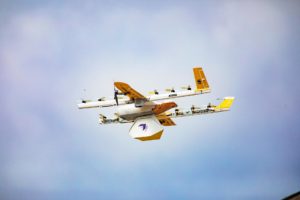The following is a guest post by tech writer Karlyn McKell. Infographic republished with permission from The Zebra. DRONELIFE neither accepts nor makes payment for guest posts.
The idea of commercial delivery drones is more relevant now than ever as social distancing guidelines have made contactless delivery an essential part of company operations. ‘
The first drone delivery was a tasty one: Dominos delivered two pizzas to a residence in New Zealand in 2016. Since then, companies have been racing towards liftoff.
While delivery drones have been in test pilot for years, many large retailers such as Amazon and Walmart are still awaiting FAA permissions to operate in the U.S. Other companies, such as UPS, have already been granted limited license to operate delivery drones in certain rural areas and for specific goods.
The Pros and Cons of Drone Delivery
Like most innovative technology, there is both positive and negative debate around the subject of delivery drones. While the devices do make delivery more efficient and eco-friendly, they also add bring more noise and privacy risks to consumers’ neighborhoods. Read on to discover the pros and cons of delivery drones.
Pros
- Clean delivery: Drones are more eco-friendly than traditional delivery methods, as they take pollutants out of the air that typically come from large trucks.
- Improves speeds: Delivery drones aim to improve the speed and efficiency of delivery. Amazon’s fleet of octocopters, according to a company press release, will be able to fly up to 15 miles and deliver packages to customers in less than 30 minutes.
- Safer transit: Delivery drones will also take more delivery drivers off the road, which will help improve the safety of delivery.
Cons
- Noise pollution: While many may be excited about speedier deliveries, others aren’t looking forward to increased noise pollution. Delivery drones don’t operate silently, and therefore will add noise pollution to areas where they fly.
- High cost: Drones carrying packages may be speedier and more convenient, but it likely won’t be cheaper. This unmanned aerial delivery method comes with higher costs in order for companies to maintain their fleet of drones.
- Privacy risks: Delivery drones are outfitted with cameras and sensors in order to track their flight. While these technological features help secure the transit, they also open up drones to security risks. Questions around hacking and privacy remain up for debate. A recent survey by The Zebra revealed that 88% of Americans don’t think delivery drones should be able to record on their property.
Check out this visual from The Zebra below to discover more about delivery drones and how they could work!

 Karlyn McKell is a writer who specializes in the technology and insurance spaces. She believes the best ingredients for success are passion and purpose.
Karlyn McKell is a writer who specializes in the technology and insurance spaces. She believes the best ingredients for success are passion and purpose.
Miriam McNabb is the Editor-in-Chief of DRONELIFE and CEO of JobForDrones, a professional drone services marketplace, and a fascinated observer of the emerging drone industry and the regulatory environment for drones. Miriam has a degree from the University of Chicago and over 20 years of experience in high tech sales and marketing for new technologies.
For drone industry consulting or writing, Email Miriam or (for paid consulting engagements only) request a meeting through AdvisoryCloud:
TWITTER:@spaldingbarker
Subscribe to DroneLife here.
https://dronelife.com/2020/04/29/the-pros-and-cons-of-drone-delivery-infographic/
 Unmanned Aerial Vehicle The latest drone news
Unmanned Aerial Vehicle The latest drone news





